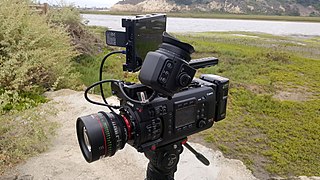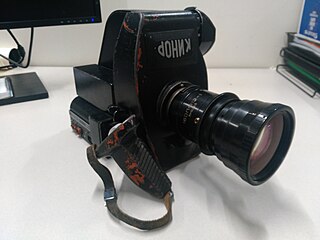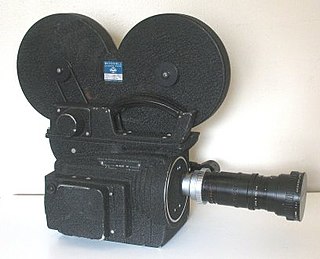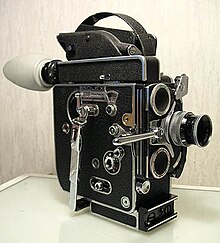
35 mm film is a film gauge used in filmmaking, and the film standard. In motion pictures that record on film, 35 mm is the most commonly used gauge. The name of the gauge is not a direct measurement, and refers to the nominal width of the 35 mm format photographic film, which consists of strips 1.377 ± 0.001 inches (34.976 ± 0.025 mm) wide. The standard image exposure length on 35 mm for movies is four perforations per frame along both edges, which results in 16 frames per foot of film.

16 mm film is a historically popular and economical gauge of film. 16 mm refers to the width of the film ; other common film gauges include 8 mm and 35 mm. It is generally used for non-theatrical film-making, or for low-budget motion pictures. It also existed as a popular amateur or home movie-making format for several decades, alongside 8 mm film and later Super 8 film. Eastman Kodak released the first 16 mm "outfit" in 1923, consisting of a camera, projector, tripod, screen and splicer, for US$335. RCA-Victor introduced a 16 mm sound movie projector in 1932, and developed an optical sound-on-film 16 mm camera, released in 1935.

8 mm film is a motion picture film format in which the film strip is eight millimetres (0.31 in) wide. It exists in two main versions – the original standard 8 mm film, also known as regular 8 mm, and Super 8. Although both standard 8 mm and Super 8 are 8 mm wide, Super 8 has a larger image area because of its smaller and more widely spaced perforations.

Super 8 mm film is a motion-picture film format released in 1965 by Eastman Kodak as an improvement over the older "Double" or "Regular" 8 mm home movie format.

Cinematography is the art of motion picture photography.

A movie camera is a type of photographic camera that rapidly takes a sequence of photographs, either onto film stock or an image sensor, in order to produce a moving image to display on a screen. In contrast to the still camera, which captures a single image at a time, the movie camera takes a series of images by way of an intermittent mechanism or by electronic means; each image is a frame of film or video. The frames are projected through a movie projector or a video projector at a specific frame rate to show the moving picture. When projected at a high enough frame rate, the persistence of vision allows the eyes and brain of the viewer to merge the separate frames into a continuous moving picture.

A zoom lens is a system of camera lens elements for which the focal length can be varied, as opposed to a fixed-focal-length (FFL) lens.

Empire is a 1965 American black-and-white silent art film by Andy Warhol. When projected according to Warhol's specifications, it consists of eight hours and five minutes of slow motion footage of an unchanging view of New York City's Empire State Building. The film does not have conventional narrative or characters, and largely reduces the experience of cinema to the passing of time. Warhol stated that the purpose of the film was "to see time go by."

Jos. Schneider Optische Werke GmbH is a manufacturer of industrial and photographic optics. The company was founded on 18 January 1913 by Joseph Schneider as Optische Anstalt Jos. Schneider & Co. at Bad Kreuznach in Germany. The company changed its name to Jos. Schneider & Co., Optische Werke, Kreuznach in 1922, and to the current Jos. Schneider Optische Werke GmbH in 1998.

Maison Brandt Frères, Charenton-le-Pont is a French manufacturer of motion picture cameras especially well known for its Super 8 and 16mm hand-held cameras, founded by Marcel Beaulieu. Marcel Beaulieu had earlier been associated with GIC cameras introduced in 1950. The company's first cameras were introduced in the early 1950s. Later they produced their first Super 8 model the 2008 S Beaulieu, introduced in 1965. Though they no longer actively produce new cameras, the company still services and repairs existing Beaulieu cameras.

The Krasnogorsk-3 (Красногорск-3) is a spring-wound 16mm mirror-reflex movie camera designed and manufactured in the USSR by KMZ. A total of 105,435 Krasnogorsk-3 cameras were produced between 1971 and 1993.

Lens speed is the maximum aperture diameter, or minimum f-number, of a photographic lens. A lens with a larger than average maximum aperture is called a "fast lens" because it can achieve the same exposure as an average lens with a faster shutter speed. Conversely, a smaller maximum aperture is "slow" because it delivers less light intensity and requires a slower (longer) shutter speed.

Anamorphic format is the cinematography technique of shooting a widescreen picture on standard 35 mm film or other visual recording media with a non-widescreen native aspect ratio. It also refers to the projection format in which a distorted image is "stretched" by an anamorphic projection lens to recreate the original aspect ratio on the viewing screen. The word anamorphic and its derivatives stem from the Greek anamorphoo, compound of morphé with the prefix aná.

Kinor is the name of a line of movie cameras produced in the USSR. All cameras under the Kinor name were intended for professional use and were equipped with a through-the-lens viewfinder with a mirror shutter, but were otherwise unrelated in their technical design as they were created by a variety of different organizations.

Standard 8 mm film, also known as Regular 8 mm, Double 8 mm, Double Regular 8 mm film, or simply as Standard 8 or Regular 8, is an 8 mm film format originally developed by the Eastman Kodak company and released onto the market in 1932.

Auricon cameras were 16 mm film Single System sound-on-film motion picture cameras manufactured in the 1940s through the early 1980s. Auricon cameras are notable because they record sound directly onto an optical or magnetic track on the same film that the image is photographed on, thus eliminating the need for a separate audio recorder. The camera preceded ENG video cameras as the main AV tool of television news gathering due to its portability–and relatively quick production turn-around–where processed negative film image could be broadcast by electronically creating a positive image. Additionally, the Auricon found studio use as a 'kinescope' camera of live video off of a TV screen, but only on early pre-NTSC line-locked monochrome systems.

Paul Ruckert was an Australian film producer and cinematographer. He was active between 1930 and 1980 and produced a wide variety of short films and documentaries under the banner of Invincible Pictures. The films included comedies, travelogues, natural history documentaries and commercials. While not achieving huge financial success with his ventures his films were sold and distributed widely within Australia and overseas. In 1999 he was recognised for his lifelong contributions with a one-hour special by Ray Martin at the end of Channel 9's "Our Century" series, as he supplied a lot of historical footage for that program.

The Canon Cinema EOS autofocus digital photographic and cinematographic SLR and mirrorless interchangeable lens camera system was introduced in late 2011 with the Canon EOS C300 and followed by the Canon EOS C500 and Canon EOS 1D C in early 2012.

EUMIG was an Austrian company producing audio and video equipment that existed from 1919 until 1982. The name is an acronym for Elektrizitäts und Metallwaren Industrie Gesellschaft, or, translated, the "Electricity and Metalware Industry Company."

Digital Bolex was a partnership between Cinemeridian, Inc. and Ienso Canada, an engineering company, to develop the Digital Bolex D16 digital cinema camera. Development was funded via a successful Kickstarter in March 2012, raising $262,661.




















